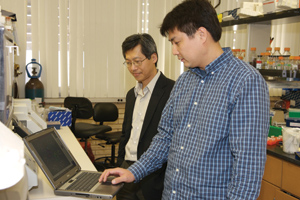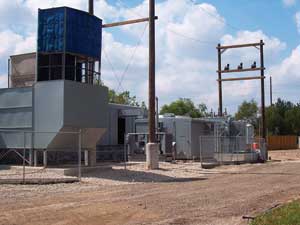May 2008
Featured

A Cheaper ‘Whey' to Make Ethanol
By Susanne Retka Schill, Photos by Brian Taylor
A Wisconsin cheese maker is expanding his bacteria-tending skills to include nurturing yeast to make ethanol and growing algae to produce oil for biodiesel in an intriguing energy-integrated, waste-to-power process.

Will RINs be: The Next Environmental Currency?
By Anduin Kirkbride McElroy
Renewable Identification Numbers are becoming increasingly important not just for people in environmental compliance or accounting, but also for those in marketing, investing and sustainability.

Testing the Water
By Ron Kotrba
Conventional wisdom says water in ethanol is bad, but a new technical understanding is emerging that could dramatically improve corn-based ethanol's environmental footprint while revolutionizing how the alternative fuel is made, transported and used.
TALK TRADE
By Timothy Charles Holmseth
U.S. ethanol producers insist the 54-cent tariff on ethanol imports needs to be in place or the government will be subsidizing Brazilian ethanol.

The Path to Commercial-Scale Cellulosic Ethanol Production
By Jessica Ebert
It's not a leap of faith that's going to make cellulosic ethanol production on a commercial level a reality. In most cases, it's going to take a plotted course that sequentially informs the evolution of cost-competitive and efficient technologies. EPM spoke with companies about the significance of piloting their technologies before scaling up to a demonstration-size facility.
Asian Scandal Cripples U.S. Enzyme company
By Sarah Smith
Once a premier bioscience company making major inroads into the ethanol industry, Dyadic is now only limping along. In the past year, it was delisted from the American Stock Exchange, ousted its founder Mark Emalfarb, was sued by angry shareholders, and released a scathing audit report detailing corruption, bribery and a dummy company skimming profits from its Hong Kong factory.

Patently Moving Ahead
By Bryan Sims
Biofuels patents have increased steadily over the past six years, according to a report published by Baker & Daniels LLP. The data also provides proof that there is an earnest effort underway to patent technological advances toward the commercialization of cellulosic ethanol production.

Flocks Or Feedstocks
By Kris Bevill
The Conservation Reserve Program encourages landowners to protect environmentally sensitive acreage. Increased demand for biofuels and a growing world population have driven crop prices to record highs. At the same time, many farmers are struggling to make a profit due to increased operating costs, and are considering letting CRP contracts expire so they can farm more land. That has prompted conservationists to wonder how the conversion will affect wildlife.
Changing the Climate
By Anduin Kirkbride McElroy and Jessica Sobolik
The National Ethanol Conference gave ethanol industry leaders a venue to discuss how the industry is changing the climate for the economy, environment and consumers.

Commercial Biorefinery Update
By Ron Kotrba
The clock is ticking on public acceptance of ethanol as the United States' corn-based industry is under relentless attack. With cellulosic conversion technologies as the ostensible lone saving grace for ethanol, Biomass Magazine takes a look at what fruits the first-quarter ‘08 produced.

Biobutanol: The Next Big Biofuel?
By Jessica Ebert
It's touted as a superior renewable fuel but challenges have stymied the industrial-scale production of biobutanol. Now, however, Dupont and BP have teamed to develop and commercialize the fuel. This comes as scientists announce advancements in the design of process technologies and the engineering of microbes aimed at improving the economics of mass-producing biobutanol.

Gas Naturally
By Jerry W. Kram
California, according to some dairy commercials, is home to happy cows. So many cows, in fact, that Pacific Gas and Electric Co. estimates that dairy manure makes up 20 percent of the state's available waste biomass for conversion into renewable fuels. The company is aggressively courting developers of anaerobic digestion and biomass gasification projects to provide biomethane for its millions of natural gas customers.
Using Peter Rabbit to Clean Peter's Pond
By Sarah Smith
Purdue University researchers have implanted poplar trees with genetic material from rabbits. The trees are destined for a Herculean task: cleaning up a contaminated site that housed an oil storage facility. The site, called Peter's Pond, was tainted by contaminated oil stored there nearly 40 years ago. The process, called phytoremediation, allows transgenic trees to slurp up underground contaminants.

Big Wood
By Simon Hadlington
Construction will start soon on a giant wood-fueled power station in Wales. But where will all that wood come from? Where will the ash go? And why not use the waste heat?
Mile Marker 105: Syntec Reaches for Economic Efficiency
By Jerry W. Kram
Biodiesel Production Trends Survey 2008
By Craig A. Johnson
For the first time Biodiesel Magazine asks producers exactly how much biodiesel is being produced. The results of our comprehensive survey create an intriguing picture of the industry. Not all producers took our phone calls, but those who did spoke loudly.

Understanding the Post-Injection Problem
By Ron Kotrba
Many diesel engine manufacturers have implemented what's called post-injection, the introduction of fuel late in the combustion cycle, as part of an advanced control strategy to reduce emissions. Biodiesel Magazine looks at how post-injection of biodiesel blends facilitates dilution of engine oil while interacting with oil additives to potentially accelerate engine wear.

A Man on a Mission
By Sarah Smith
When President George W. Bush proclaimed biodiesel the most promising renewable fuel, one that could help meet his 36 billion-gallon goal, he was likely unaware that this mandate would set off a debate now taking place across America: don't build here or anywhere near here.
Will RINs be the Next Environmental Currency?
By Anduin Kirkbride McElroy
Renewable Identification Numbers are becoming increasingly important not just for people in environmental compliance or accounting, but also for those in marketing, investing and sustainability.
The 'FOG' is Lifting
By Kris Bevill
San Francisco is on its way to becoming an even brighter shade of green by starting a program to collect the waste fat, oil and grease (FOG) that clog city sewers and cost taxpayers millions, and turning it into biodiesel to fuel the city's fleet.

Gaining Traction
By Susanne Retka Schill
The nation's underground mines are turning to biodiesel to reduce diesel particulate matter levels to help comply with tighter air quality limits.

Gallons of Megawatts
By Jerry Kram
Most think of biodiesel as a motor fuel. But it is much more versatile and can drive steamships and, notably, gas turbines. A group in Texas has been pushing the frontiers of biofuel technology to bring electricity to the suburbs of Houston.

Can Biodiesel Power Haiti?
By Eric Kroh
The Western hemisphere's poorest nation faces the same dire problems with fuel cost that the rest of the world encounters. But for once Haiti may have a head start. Its farmers already work with a native plant called jatropha.
Earthrace begins voyage using sustainable fuels
By Timothy Charles Holmseth
Contributions

Vive la Difference
By Jon Evans
Biofueling the economies of Europe and United States has taken distinctly different routes. The Yanks are well ahead in ethanol, but the second generation may look different.
Chernobyl's Harvest
By Patti McCracken
For the Iowa-size area around the site of the world's worst nuclear disaster, it's not just the air, but the soil, that stands to benefit from biofuels.

The Industry: Yesterday, Today and Tomorrow
By Larry Johnson
Coordinating Biomass Research
By Mary-Anne Fiebig
Research into all facets of biomass-supported industries is taking off at schools throughout the country. North Dakota State University is combining and coordinating its efforts to a better biobased program.






















